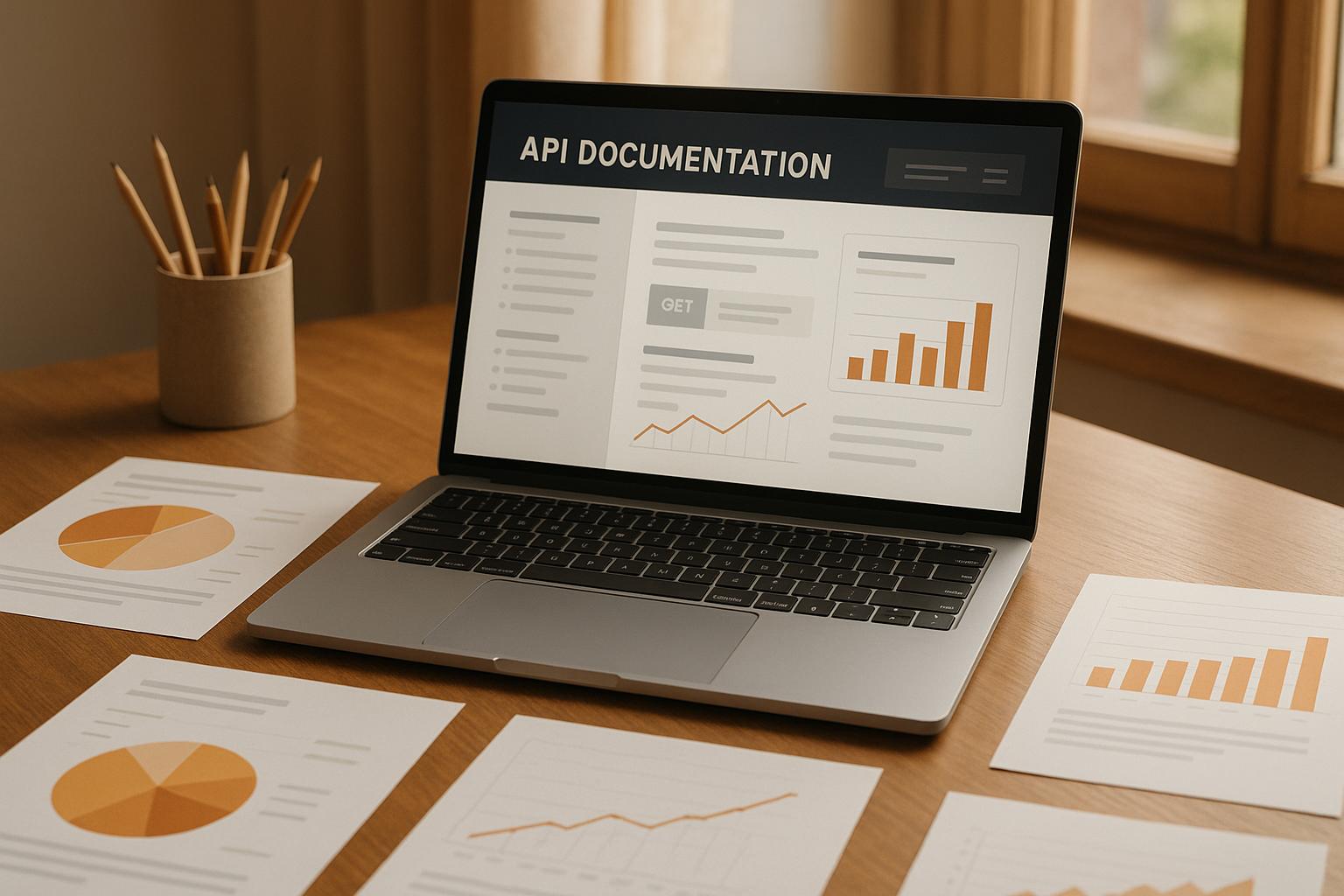Ultimate Guide to API Documentation Metrics

API documentation metrics measure how effectively your documentation helps developers integrate and use your API. These metrics focus on improving usability, reducing errors, and driving API adoption. Key metrics include:
- Time to First Hello World (TTFHW): Tracks how quickly developers make their first API call.
- Adoption and Retention Rates: Measures how many developers use and continue using your API.
- Error Rates: Identifies areas where unclear documentation causes mistakes.
- Developer Feedback: Surveys and support ticket analysis highlight pain points.
Why does this matter? Metrics help you spot issues early, improve developer experience, and tie documentation quality to business outcomes like faster onboarding, lower support costs, and higher API adoption. For example, companies like Goldman Sachs and JP Morgan Chase have used these metrics to cut costs and improve customer satisfaction.
To get started, use tools like Google Analytics, Hotjar, or Moesif to track engagement and API usage. Combine quantitative data with developer feedback to make targeted updates that solve real problems. Ultimately, better metrics mean better APIs - and better business results.
Key Metrics for Evaluating API Documentation
To improve API documentation and drive better outcomes, it's essential to measure both hard data and developer sentiment. Quantitative metrics provide measurable insights, while qualitative metrics capture the developer's overall experience.
Quantitative Metrics
-
Documentation Time to Value (DTTV)
This measures how quickly a developer can find the information they need and achieve their first meaningful result. A lower DTTV indicates that your documentation is clear and well-structured. -
SDK and Version Adoption
Tracks the usage of different versions of your Software Development Kit and API. If newer versions have low adoption, it might mean your migration guides or explanations of new benefits need improvement. -
API Calls by Application Type
Evaluates how often various platforms - like web apps, mobile apps, or IoT devices - make API calls. Discrepancies in usage might highlight a need for better platform-specific documentation. -
Error Rates
High rates of 4xx errors can indicate sections where unclear documentation is causing developers to make mistakes. Repeated issues in specific areas suggest the need for clearer instructions or additional examples. -
Portal Performance and Web Analytics
Metrics like Time to First Byte (TTFB) and average latency measure how responsive your documentation portal is. Web analytics - such as page views, unique visitors, time on page, and bounce rates - can reveal how engaging your content is. For example, high bounce rates on key pages might mean the content isn’t meeting user expectations. -
Churn Rate
This metric calculates the percentage of developers who stop using your API over time. Use the formula:
(Number of developers lost / Number of developers at the start) × 100.
A high churn rate could signal documentation gaps that limit developers from fully utilizing your API.
Qualitative Metrics
While numbers are important, developer feedback offers insights you can’t get from data alone. Here are some ways to gather qualitative input:
-
Developer Satisfaction Scores
Use embedded surveys at key points, such as after tutorials or API endpoint interactions, to capture immediate feedback. Asking specific questions like, "What was the most confusing part of the API documentation?" can provide actionable insights. -
Support Ticket Analysis
Analyze the volume and nature of support tickets to identify recurring issues tied to unclear or incomplete documentation. This can pinpoint specific areas that need clarification.
"APIs are only as good as their usability. The best API may have powerful features, but if developers find it hard to understand, integrate, or troubleshoot, adoption will suffer."
– Zigpoll
"If you're not running these API developer feedback surveys, you're ignoring key drivers of API adoption, missing chances to reduce support escalations, and losing competitive edge as your documentation lags behind what users need. Regular feedback ensures your docs are always aligned with real-world needs - boosting developer satisfaction and product success."
– Adam Sabla, Specific
- Natural Language Processing (NLP) Analysis
Use NLP tools to analyze open-ended survey responses. This approach helps identify recurring frustrations, themes, and suggestions at scale.
Best Practices for Metric Definitions
To ensure consistency and actionable insights, it's critical to define your metrics clearly. Start by outlining exactly what each metric measures and ensure everyone managing API documentation is on the same page. When designing surveys, use specific and targeted questions instead of generic ones to gather detailed feedback. Regularly revisit your metric definitions and adjust them as your API evolves, ensuring your data stays accurate and relevant.
Methods for Collecting and Analyzing Metrics
Gathering data on how developers interact with your API documentation requires a mix of tools and strategies. By using multiple sources, you can capture both quantitative and qualitative insights to better understand user behavior and improve your documentation. Here’s a breakdown of effective methods for collecting and analyzing these metrics.
Data Collection Methods
To measure your documentation’s performance, leverage the following data sources:
Web Analytics Platforms are a cornerstone for tracking engagement. Google Analytics is a popular choice for monitoring key metrics like page views and user behavior. It also allows you to set up custom events, such as tracking tutorial completions or feedback submissions.
For teams prioritizing data privacy, Matomo is a powerful open-source alternative. It offers similar tracking capabilities but allows for self-hosted analytics, giving you greater control over your data.
Behavior Analytics Tools like Hotjar provide insights that go beyond numbers. These platforms track user sessions, showing how developers interact with your content. Heatmaps highlight the most engaging sections, while session recordings can pinpoint areas where users might struggle or lose interest.
API Monitoring Solutions focus on how your documentation translates into API usage. Tools like APItoolkit and Moesif API Analytics track which endpoints developers access after reading specific documentation sections. They can also monitor error rates, helping you identify unclear or problematic instructions.
In-Product Feedback Systems collect real-time developer feedback. Features like embedded surveys, rating widgets, and comment sections allow users to share their experiences immediately after interacting with your content. These tools work best when placed after key milestones, such as completing a tutorial or viewing an endpoint reference.
Support Ticket Analysis is another valuable source of information. By examining support requests, you can identify recurring issues that point to documentation gaps. Platforms like Zendesk or Intercom can automatically tag tickets by topic, making it easier to spot trends and address common pain points.
Techniques for Analyzing Metrics
Once you’ve gathered your data, the next step is to analyze it effectively. Use these methods to uncover trends and refine your documentation:
Time-Series Analysis helps track changes in documentation usage over time. By analyzing data in 28-day intervals, you can account for variations between weekdays and weekends. This approach is useful for evaluating whether updates to your documentation lead to sustained improvements in developer engagement.
Correlation Analysis identifies relationships between different metrics. For example, if pages with longer average reading times also show higher API adoption rates, it might suggest that more detailed content encourages better outcomes.
Percentile Analysis digs deeper into performance data. While the average time to a first successful API call might be two hours, the 99th percentile could reveal outliers who take significantly longer. This helps identify specific pain points that might not be obvious from averages alone.
Funnel Analysis tracks the user journey from landing on your documentation to successfully integrating your API. By pinpointing where developers drop off, you can prioritize improvements to address the most critical hurdles.
"Analytics can be a beacon of light in the often complex and dark realm of documentation."
– APItoolkit
Comparing Collection Tools
Choosing the right tools involves balancing accuracy, ease of use, and cost. Here’s a quick comparison of some popular options:
| Tool Category | Best For | Key Strengths | Typical Monthly Cost |
|---|---|---|---|
| Google Analytics | Basic web metrics and user behavior | Free, easy setup, customizable dashboards | $0 |
| Hotjar | User experience and behavior analysis | Heatmaps, session recordings, feedback tools | $32+ |
| Moesif API Analytics | API usage tracking | Developer journey insights, adoption metrics | Custom pricing |
| Sematext Synthetics | API performance monitoring | Multi-location testing, detailed response data | $2–7 per monitor |
| Postman | API testing and documentation | Integrated testing, monitoring, collaboration | $14+ per user |
For a well-rounded approach, combine tools like Google Analytics for basic metrics, Hotjar for user behavior insights, and an API-specific platform like Moesif for tracking developer success. If budget is a concern, focus on tools that align with your workflow and deliver the most critical metrics for your goals.
Ultimately, the best analytics setup is one that you consistently use to make informed improvements to your documentation.
Using Metrics to Improve API Documentation
Turning analytics into actionable steps can transform your API documentation into a tool that genuinely supports your developer community. By carefully analyzing metrics and making targeted updates, you ensure your documentation addresses real-world needs.
Interpreting Results and Identifying Trends
Understanding your documentation's performance starts with spotting patterns in the metrics. For instance, if you notice spikes in 400-level errors, it’s worth digging into specific endpoints and error types. Persistent malformed requests to a particular endpoint might mean your request examples or schema definitions need more clarity. Similarly, frequent 401 errors could point to gaps in your authentication instructions.
"500 errors could imply bad things are happening with your code whereas many 400 errors could imply user errors from a poorly designed or documented API." - Moesif Blog
Another key metric to watch is Time to First Hello World (TTFHW). If developers are taking longer than expected to make their first successful API call, it could signal that your getting started guides need to be more straightforward.
"API product teams mostly rely on [Time to First Hello World] to measure how fast a developer can sign up and make their first successful API call." - Keval Bhogayata, middleware.io
Breaking this metric down by developer experience level can uncover specific challenges. New developers might struggle with basic integration steps, while seasoned developers could face issues with API-specific nuances.
API usage patterns can also reveal inefficiencies. For example, if developers are making multiple API calls to complete simple tasks, it might indicate that your documentation isn’t guiding them toward more efficient workflows.
"This [API Calls per business transaction] metric directly reflects the design of the API. If a new customer has to make 3 different calls and piece the data together, this can mean the API does not have the correct endpoints available." - Moesif Blog
Additionally, a significant drop-off between sign-ups and active API usage could point to friction in the onboarding process, suggesting that your documentation - or the overall integration experience - needs attention.
"If web MAU is growing far faster than API MAU, then this could imply a leaky funnel during integration or implementation of a new solution." - Moesif Blog
These insights provide a solid foundation for making targeted improvements.
Actionable Documentation Updates
Once you’ve identified problem areas, focus on updates that will have the most impact. Start with common pain points and make achievable changes to improve the overall developer experience.
For high 4xx error rates, refine your request examples and clarify schema definitions. Add troubleshooting guides with examples of common errors, and include updated code samples in popular programming languages.
If TTFHW is too high, streamline your onboarding process with a concise quick-start guide. Interactive tools like API explorers or sandboxes can also help developers test endpoints without needing to write code right away.
For issues with SDK adoption or version upgrades, ensure your documentation clearly highlights the benefits of newer versions. Provide detailed migration guides with relevant examples, and maintain clear upgrade instructions to assist developers.
Support tickets can also be a goldmine for identifying documentation gaps. If certain questions or issues keep coming up, use that feedback to create FAQ entries or detailed troubleshooting sections.
Tailor your content to match how developers use your API. For example, if a large portion of your audience consists of mobile developers, include tutorials that address platform-specific challenges they’re likely to face.
Continuous Improvement Through Feedback Loops
Improving documentation is an ongoing process that thrives on structured feedback. Start by defining clear goals - whether it’s reducing support tickets, speeding up onboarding, or increasing API adoption.
Set up multiple feedback channels to gather input from a diverse audience. Adding feedback widgets directly into your documentation allows developers to rate sections or leave comments as they use it. Automated prompts after milestones, like completing a tutorial or making a first API call, can also provide valuable insights.
"When customers take the time to give feedback, not hearing anything back is a major letdown. Don't leave them wondering. Instead, make sure customers feel heard, valued, and appreciated." - Kyo Zapanta, Author, getthematic.com
Analyze this feedback by categorizing comments and identifying recurring themes. Tools can help process open-ended responses and prioritize updates based on how often issues arise and their impact on metrics like user adoption or churn.
Transparency is key when acting on feedback. Share your plans for updates and include “You Said, We Did” sections in release notes or changelogs to show developers that their input matters. This builds trust and strengthens your relationship with the community.
Finally, track the results of your updates by monitoring metrics like developer satisfaction, onboarding times, and support ticket volume. By continuously cycling through feedback, analysis, and updates, your API documentation can evolve to meet developers’ needs effectively.
Focus on feedback that aligns with your key metrics, and be clear about why certain suggestions are or aren’t implemented. This approach ensures your documentation stays relevant and impactful while maintaining trust with your audience.
sbb-itb-e766981
Integrating Metrics into API Ecosystem Management
Incorporating API documentation metrics into your ecosystem management is essential for driving better business outcomes and maintaining a competitive edge. Let’s explore how these metrics can simplify developer onboarding and encourage API adoption.
Supporting Developer Onboarding and Adoption
A smooth onboarding process is a cornerstone of API adoption. One key metric to track is Time to First Hello World (TTFHW), which measures how quickly developers can execute their first API call.
"A low TTFHW means your API is easy to use and onboard with. High TTFHW? It could mean your documentation is confusing, authentication is complex, or your API lacks sandbox/testing environments." - Digital API
Rabobank's transition to a self-service platform is a great example of success in this area. By using metrics to identify and eliminate onboarding bottlenecks, they increased deployment velocity by 10x and improved developer satisfaction.
Another critical metric is Monthly Active Users (MAU), which gives insight into how well your API attracts and retains developers. This metric highlights whether developers continue to find value in your API after onboarding. Unlike web retention, API retention tends to be higher because it focuses on users who have already invested in integration.
"For many product managers, as more users depend on APIs to run their applications, API usage (along with unique consumers) is the gold standard to measure API adoption." - Moesif Blog
Additionally, track API Calls per Business Transaction to assess the efficiency of your API design. This data can guide decisions like creating composite endpoints to streamline processes.
To ensure your APIs remain relevant, establish feedback loops by monitoring usage and creating channels for developers to report issues. This approach allows your APIs to evolve based on actual user needs rather than operating in isolation.
These onboarding metrics naturally tie into broader strategies for data-driven decision-making.
Making Data-Driven Decisions
Metrics are powerful tools for turning raw data into actionable insights. Analyzing API latency and error rates by endpoint, region, or customer segment can help pinpoint areas that need improvement.
"High error rates can negatively impact user experience by causing slow loading times and timeouts. In order to track errors per minute, it's important to understand what type of errors are happening. 500 errors could imply bad things are happening with your code whereas many 400 errors could imply user errors from a poorly designed or documented API." - Moesif Blog
Start by establishing baselines for normal API behavior, including average request frequency, payload sizes, and timing patterns. These benchmarks make it easier to detect anomalies and address potential security threats or performance issues before they affect users.
While most teams aim for 99.9% uptime, pushing for 99.99% or even 99.999% uptime can become increasingly complex and costly. Use your metrics to determine the right reliability level based on user needs and business goals.
Metrics also help connect API performance to broader business goals. For example, linking API errors to drops in completed purchases or showing how successful onboarding impacts customer lifetime value can justify investments in documentation and infrastructure improvements.
Security metrics are equally important. Monitor unauthorized access attempts, rate limit violations, and unusual traffic patterns. For instance, T-Mobile's November 2022 incident, where hackers exploited API vulnerabilities to steal data from 37 million accounts, highlights the importance of proactive monitoring.
Automate responses to anomalies with measures like rate limiting, forced re-authentication, or temporary API deactivation. These actions should be triggered by metrics thresholds to ensure swift and effective intervention.
These data-driven insights pave the way for strategic planning and advisory services.
Role of Advisory Services in Using Metrics
While metrics can drive operational improvements, many companies struggle to translate them into strategic decisions. This is where specialized advisory services come in.
Phoenix Strategy Group, for example, helps businesses integrate API documentation metrics into their financial and strategic planning. Metrics like developer adoption rates, API performance, and ecosystem health are often scrutinized by investors during funding rounds or acquisitions because they directly affect valuation and growth potential.
"Organizations that treat APIs as products - measuring adoption, latency, error rates, and business outcomes - are better positioned to scale integrations without accumulating technical debt." - Token Metrics Team
Advisory services can also help establish API governance frameworks aligned with business goals. This might include setting criteria for scaling API gateways based on metrics like requests per minute or exception rates, ensuring reliability while managing infrastructure costs.
Financial planning for API ecosystems involves understanding how documentation quality, developer adoption, and revenue growth are interconnected. Advisory teams can model these relationships and forecast how improving developer experience can amplify business outcomes.
"API documentation is one of the top four things leaders consider when deciding whether to integrate with a third-party API." - Postman's 2022 State of the API report
For companies preparing for acquisitions, showcasing comprehensive API metrics can demonstrate operational maturity and scalability, often influencing valuation negotiations. Phoenix Strategy Group specializes in presenting these metrics in ways that highlight competitive advantages and growth opportunities.
The goal is to move beyond basic monitoring and use metrics strategically. For example, linking API performance to customer satisfaction, showing how better documentation reduces support costs, or proving how ecosystem health drives revenue growth.
"API metrics aren't just numbers on a dashboard - they're the compass that guides your digital strategy." - Digital API
Conclusion and Key Takeaways
API documentation metrics aren’t just random numbers - they’re the backbone of thriving API ecosystems that fuel business success. When used effectively, these metrics turn documentation from a static resource into a dynamic tool for driving developer engagement and business growth.
Here’s the proof: Google Analytics reports that pages with clear examples see up to 40% higher engagement, while New Relic found that metric-driven updates can cut support tickets by 25–30% in just six months. These stats highlight the power of tracking both quantitative metrics (like page views, time spent on a page, and bounce rates) and qualitative feedback (like developer surveys and support interactions) to get a full picture of how your documentation is performing.
If you notice high bounce rates or a surge in support tickets after an API update, don’t wait to act. For example, a U.S. fintech company saw a 30% improvement in onboarding and a 20% drop in related support tickets simply by clarifying confusing authentication instructions.
To truly make an impact, align your documentation metrics with your business objectives. This not only drives developer adoption but also supports revenue growth - critical factors during funding rounds or acquisition discussions.
Organizations like Phoenix Strategy Group take this approach a step further, combining technical insights with financial strategy. By integrating documentation metrics into growth and financial planning, they help growth-stage companies turn raw data into actionable strategies.
The takeaway? Treat your API documentation as a strategic asset. By tracking metrics, collecting feedback, and making data-driven updates, you can build an API ecosystem that scales with your business goals and creates lasting success.
FAQs
How can I use API documentation metrics to enhance developer onboarding and reduce support tickets?
To make onboarding smoother for developers and cut down on support tickets, it’s essential to monitor a few key metrics: time to first successful API call, onboarding completion rates, and support ticket volume per API call. These numbers can reveal where developers might be running into issues, giving you a clear path to refine your documentation and make it easier to use.
Steps like offering interactive, developer-friendly documentation, keeping version control organized, and providing quick access to examples and troubleshooting guides can make a big difference. These efforts not only simplify the onboarding process but also reduce the likelihood of developers needing extra support, ensuring a more seamless experience overall.
What are the best practices for tracking and analyzing API documentation metrics?
To keep a close eye on API documentation performance, it's important to track both quantitative and qualitative metrics. Quantitative data, such as engagement rates, error rates, and response times, gives you clear, measurable insights into how users interact with your documentation. On the other hand, qualitative data, like user feedback and satisfaction scores, adds depth by highlighting how clear and user-friendly your content is.
The best way to get a complete picture is by blending these two types of data. Make sure your data is accurate, and leverage analytics tools to spot trends and areas for improvement. This balanced approach allows you to fine-tune your documentation and create a better experience for your users.
How do API documentation metrics impact business success and strategic decisions in API management?
API documentation metrics are essential for guiding business decisions and ensuring success. They provide critical insights into how APIs perform, how users interact with them, and how effectively they operate. Metrics such as uptime, request volume, error rates, and developer adoption play a key role in maintaining API reliability, improving user satisfaction, and aligning API strategies with business objectives like boosting revenue or cutting costs.
By analyzing these metrics, companies can make smarter decisions, refine API management practices, and support growth initiatives. This not only improves operational efficiency but also helps businesses strengthen their competitive edge, delivering better experiences and results for their users.




